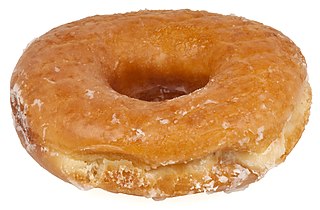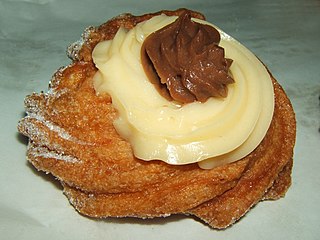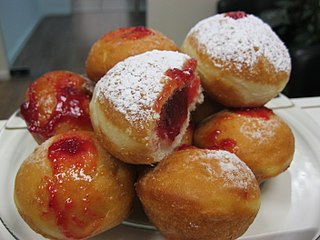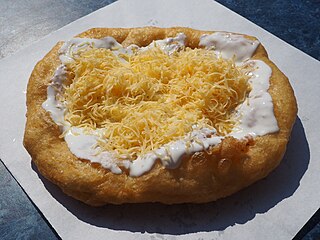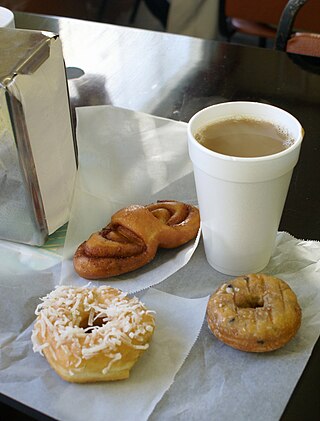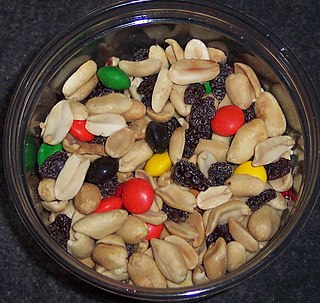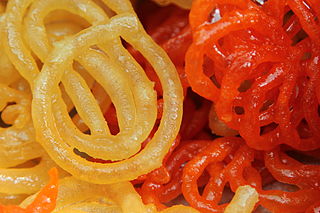Fried dough foods
| Name | Image | Origin | Description (including main ingredients and notable aspects) |
|---|---|---|---|
| Akara, Acarajé |  | Nigeria, Brazil | Fried dough made from ground black-eyed peas or black-eyed pea flour. Onions, peppers, and salt to taste are added for more flavor. Typically eaten as a breakfast with "pap", or custard locally called akamu by Igbo people. |
| Achappam |  | Kerala, India | Sweet, shaped like a star |
| Awameh |  | Levant | is a kind of fried-dough Levantine pastry similar to doughnut holes, made of deep fried dough, soaked in sugar syrup or honey and cinnamon, and sometimes sprinkled with sesame. |
| Bambalouni |  | Tunisia | A sweet donut, made from frying dough in oil, eaten with sugar on top or honey |
| Bamiyeh, zulbiā, ballıbadı |  | Iran, Azerbaijan | Traditional treat made from a yogurt and starch-based dough, which is fried before being dipped in syrup. Similar to Turkish tulumba. |
| Bánh chuối chiên | Vietnam | Banana fritter. Several varieties of banana may be used. | |
| Bánh gối |  | Vietnam | Empanada-like pastry filled with minced cellophane noodles, minced pork, cloud ear fungus, and thin slices of Chinese sausage. |
| Bánh rán, bánh cam |  | Vietnam | Glutinous rice ball coated with white sesame seeds and filled with sweetened mung bean paste. |
| Bánh rế | Vietnam | Sweet potato pancake. | |
| Bánh tôm (bánh tôm Hồ Tây) |  | Vietnam | Sweet potato–battered shrimp fritter. |
| Bánh xèo |  | Vietnam | Savory pancake made with rice flour and turmeric and stuffed with various ingredients |
| Bannock |  | Canada | Also called frybread |
| Bannock |  | Scotland | A bread the same thickness as a scone. Native Americans and particularly Métis, in western Canada and the northern Great Plains in the United States, adopted bannock in their own cuisine over the 18th and 19th centuries. |
| BeaverTails |  | Canada | Pastries [1] - registered trademark, oblong shaped fried dough, like a beaver tail (Hence the name) |
| Beignet |  | France | The pastry is also present in New Orleans, Louisiana, as a deep-fried choux pastry covered with confectioner's sugar in the U.S. and Belgium, and sometimes described as a French doughnut; however, as with other variants of fried sweet pastry, the beignet typically has its own distinctive characteristics (shape and texture). These differences are sufficient in the minds of some of beignet devotees to object to it being considered a doughnut. |
| Berliner |  | Germany and Switzerland | The doughnut equivalents, typically do not have the typical ring shape (except for a variety in southern Germany as so-called Auszogne which have a ring shape but a skin in the middle) but instead are solid, usually filled with jam. (German doughnuts are sometimes called "Berlin doughnuts" in the US.) |
| Bhatoora |  | Indian Punjab, Pakistan | Very chewy bread made by flattened dough being fried until it puffs into a light brown fluffy form. |
| Binangkal |  | Philippines | Deep-fried flour balls covered with sesame seeds |
| Bolang Baling (also known as Odading) |  | Indonesia | Deep-fried sweet dough balls covered with crystal sugar or sesame seeds. Possibly influenced from the Dutch Oliebollen. |
| Bolinho de chuva |  | Brazil | Deep-fried sweet dough balls |
| Bomboloni |  | Italy | Similar to German Berliner, with a cream (or chocolate) filling. |
| Boortsog |  | Central Asia | A fried dough food found in the cuisines of Central Asia, Idel-Ural, and Mongolia. They may be thought of as cookies or biscuits, and since they are fried, they are sometimes compared to doughnuts. |
| Bugnes |  | Italy, France | |
| Buns | Nigeria | A fried dough ball snack similar to puff-puff, excluding the yeast. | |
| Buñuelo |  | Spain | They typically consist of a simple, wheat-based yeast dough, often flavored with anise, that is thinly rolled, cut or shaped into individual pieces, then fried and finished off with a sweet topping. Buñuelos are first known to have been consumed among Spain's Morisco population. Its variants are widespread in former Spanish colonies. |
| Cascaron |  | Philippines | A variant of buñuelo from the Philippines made with ground glutinous rice and coconut milk. Usually eaten on skewers. |
| Çäkçäk |  | Tatarstan, Bashkortostan (Russia) | A sweet made from unleavened dough cut and rolled into hazelnut-sized balls, which are then deep-fried in oil. |
| Chakli (Murukku) |  | India | A South Indian snack of savory crunchy twists made from rice and urad dal flour. [2] Murukku means twisted in the Tamil language. [3] The town of Manapparai in Tamil Nadu is particularly known for its murukku. [4] Murukku is made in many varieties as a traditional treat for festivals such as Diwali and Krishna Janmashtami. [5] Murukku are often served on special occasions within Iyer (Tamil Brahmin) families. [6] |
| Chapssal doughnut |  | Korea | Chewy, mildly sweet doughnuts made with glutinous rice flour and filled with sweetened red bean paste. |
| Chiacchiere |  | Italy | And lattughe in Lombardy |
| Cenci | Italy | And Donzelle in Tuscany- Chiacchiere (also called cenci - lit. 'rags') can be served with honey on top (or powdered sugar). Donzelle are stripes of fried bread dough, usually served with ham and mozzarella. | |
| Chiburekki |  | Central Asia, Crimea, Russia | A fried turnover with a filling of ground or minced meat and onions. It is made with a single round piece of dough folded over the filling in a half-moon shape. A national dish of the Crimean Tatars, it is also popular throughout Central Asia, Russia, Ukraine, Turkey. |
| Churro |  | Spain | A thin cylinder of deep-fried pastry with a characteristic 'ridged' surface, due to being extruded through a star shaped hole. Churros are often served for breakfast or in local fiestas, matched with thick chocolate paste or white coffee. They are sometimes homemade or bought frozen to fry at home, but most are bought at cafes or from fixed or ambulatory churrerías. |
| Ciambelle |  | Italy | The doughnut equivalents (but they are never glazed) |
| Coxinha |  | Brazil | A croquette-like food with chicken filling. |
| Croquettes |  | Europe | Usually made of mashed potato. |
| Crostoli |  | Italy | Or crostui in Friuli Venezia Giulia |
| Curry bread |  | Japan | A curry-filled bread, dipped in panko and deep fried. It is usually pre-packaged and sold in convenience stores and bakeries. |
| Dutchie |  | Canada | Originated at Tim Horton's restaurants, is a square doughnut-like pastry topped with raisins and a sugary glaze |
| Elephant ears |  | United States | Fairground specialty, a large, flat round fried yeast dough, often covered in fruit or sugar, also called fried bread, fried dough, Whales Tails, tiger ears, pizza frita, frying saucers, doughboys. Similar to Canadian BeaverTails |
| Empaná | Curaçao, Aruba, and Bonaire (Caribbean) | Dough made from pre-cooked cornmeal, salt, sugar, aniseseed, butter, and water. It can have various fillings and is fried in oil. The filling can be ground meat, cheese, chicken, or tuna. Empaná's are sold at all places that cater to eaters on the go during the day as a filling snack but mostly in the morning as a fast breakfast item. At parties often smaller sized ones are served. | |
| Falafel |  | Middle East | Deep-fried balls of ground chickpeas or fava bean. Very popular amongst vegans and vegetarians as an alternative to kebab, as it is served alongside hummus, wrapped in a lavash with fresh vegetables and various sauces, and usually available in kebab spots. |
| Fartura |  | Portugal | Fairground specialty, fried in a spiral and then snipped into pieces that are powdered with sugar (see fartura) |
| Faworki |  | Poland | Also known as chrust, is a fried, crispy flat dough, sometimes twisted and sprinkled with confectioners' sugar. |
| Flancati |  | Slovenia | Rectangular, fried yeast dough topped with powdered sugar. |
| Frappe | Italy | And Sfrappole in Emilia Romagna | |
| Festival | Jamaica | Fried sweet dough [7] | |
| Fried pie | United States | Deep-fried pastry with filling, typically fruit. | |
| Fish cracker |  | Southeast Asia | Deep-fried crackers made from starch and fish |
| Fried bread |  | United Kingdom | Triangular (usually) quarter or half slices of white bread fried in, traditionally, bacon dripping, and served on a plate with eggs, bacon, sausage, black pudding, beans and tomatoes as part of a traditional "Full English breakfast". |
| Fried Coke |  | United States | A creation made in the summer of 2006 which has proven very popular in Texas. Batter is mixed with Coca-Cola syrup and fried, after which it is topped with more Coke syrup or whipped cream, a cherry, etc. [8] |
| Frittelle |  | Italy | |
| Fritter |  | Any kind of food coated in batter and deep fried. Although very similar to a doughnut it differs in the fact that it requires some base ingredient beyond the dough it is cooked with. | |
| Fritule |  | Croatia | |
| Frybread |  | United States | Frybread is a Native American fried dough which may range from bread-like to donut-like depending on the region, as many tribes use different recipes. |
| Fry jack |  | Belize | Fry jacks are typically served at breakfast. |
| Funnel cake |  | United States | A creation which is made with fried sweet pastry where the pastry dough is extruded through a funnel into a pan of hot oil and allowed to "criss-cross" in the oil until the string of dough fills the bottom of the pan in a kind of tangled spaghetti-like arrangement, which is cooked as a cake rather than an individual snack. Funnel cakes are usually associated with carnivals, fairs, amusement parks, and seaside towns, much like cotton candy. |
| Gogoşi |  | Romania | Round or ring shaped, fried dough usually topped with powdered sugar or filled with fruit jam or chocolate cream. |
| Gorgoria |  | Philippines | A crunchy glazed fried dough cookie from the Philippines. |
| Haliva |  | Circassia (Russia) | A fried dough turnover filled with either potatoes or Circassian cheese. |
| Hirschhörner | Germany | A dough that uses Hirschhornsalz and Pottasche as leavening agents. The dough is rolled out thin, cut into diamonds. One corner is pulled through a slit cut in the middle of each diamond. They are then deep fried, dripped off and turned over in a bowl of granulated sugar until covered. A Northern German specialty prepared on New Year's Eve. | |
| Hushpuppies |  | United States | Savory fried dough balls made from a heavy cornmeal batter |
| Jalebi |  | India, Pakistan, Bangladesh, Nepal | (Hindi : जलेबी, Urdu : جلیبی, Punjabi : ਜਲੇਬੀ, Telugu : జిలేబి), Jilapi (Bengali : জিলাপী), Jeri (Nepali : जेरी) This is a deep-fried sweet batter with rose water and saffron. Similar to Persian Zoolbiya. |
| Jersey wonders |  | Jersey | These are also known as Mèrvelles |
| Jin deui |  | China | A hollow fried pastry made of glutinous rice flour that is coated with sesame seeds and filled with a sweet filling. |
| Johnny Cake | US Virgin Islands | Unleavened, golden-sweet, semi-flattened, fluffy-fried bread made primarily of white flour. | |
| Kabkab |  | Philippines | Deep-fried cassava wafers |
| Kachori |  | India | Dough balls filled with different kinds of savoury stuffings like de-skinned moong bean, de-skinned black gram, etc. along with salt, pepper, red chili powder and other spices. |
| Kachori |  | Pakistan | Doughnuts filled with ground beef or lamb and deep fried. Vegetarian ones often contain potatoes. |
| Karintō |  | Japan | |
| Khuushuur |  | Mongolia | A fried turnover with a filling of ground or minced meat (beef or mutton), onions or garlic, and other spices. |
| Kiping |  | Philippines | Leaf-shaped glutinous rice wafers |
| Kkwabaegi | Korea | Twisted doughnut from Korea | |
| Khvorost |  | Russia | In Russian Хворост, crisp pastry made out of dough shaped into thin twisted ribbons, deep-fried and sprinkled with powdered sugar |
| Kleina |  | Iceland | (Plural Kleinur) |
| Klejne |  | Denmark | (Plural "Klejner") |
| Koeksister |  | South Africa | A traditional South African confectionery made of fried dough infused in syrup or honey. The name derives from the Dutch word koek, which generally means a wheat flour confectionery, also the origin of the American English word "cookie" |
| Krafne |  | Croatia | From German Krapfen |
| Krapfen |  | Austria, Bavaria and South Tyrol | Round, fried dough typically filled with apricot jam or vanilla cream and topped with powdered sugar. |
| Krhki flancati |  | Slovenia, Istria | Rectangular, cut and twisted fried dough topped with powdered sugar. |
| Krofi |  | Slovenia | Round, fried yeast dough filled with apricot or blueberry jam and topped with powdered sugar. |
| Kroštule |  | Croatia | Other local names: hruštule, hrustule, hrostule, krustavice, krustule (From Latin Crustulum – cookie, pastry). |
| Kumukunsi | Philippines | A deep fried rice cake made from rice flour, duck eggs, and sugar cooked into spiral shapes. | |
| Lakhamari |  | Nepal | A fried sweet indigenous to Kathmandu Valley and surrounding areas. |
| Lángos |  | Hungary | |
| Laufabrauð |  | Iceland | A traditional kind of Icelandic bread that is most often eaten in the Christmas season. [9] Originating from northern Iceland but now eaten throughout the entire country, [9] it consists of round, very thin flat cakes with a diameter of about 15 to 20 cm (5.9 to 7.9 in), decorated with leaf-like, geometric patterns and fried briefly in hot fat or oil. [10] |
| Lihapiirakka |  | Finland | A savoury doughnut (without a hole) filled with minced meat and rice. |
| Lokma or Loukoumades |  | Turkey, Greece | Somewhat like crisp doughnut holes, loukoumades (pronounced loo-koo-MA-thes) consist of deep-fried dough balls marinated in honey and cinnamon. |
| Lokot-lokot | Philippines | Deep-fried ground glutinous rice fried into noodle-like strings and usually rolled into cylinders | |
| Lörtsy |  | Finland | A thin, half-moon shaped pastry originally from Savonlinna, eastern Finland. It is made with a variety of fillings; the most common ones are either a savory meat filling or a sweet apple filling. |
| Luchi |  | India (Eastern) Bangladesh | Made of wheat flour typical of Oriya, Assamese and Bengali cuisine, dough is made by mixing fine maida flour with water and spoonful of ghee, then divided in small balls, flattened by rolling-pin, individually deep-fried in cooking oil or ghee, 4-5 inches diameter, usually served with curries or gravies. |
| Luqmat al-qadi | Middle East | (لقمة القاضي) literally, judge's mouthful, this is a relative and etymological ancestor of the Greek Loukoumas. Also called sfingis (in Arabic) and lokma (Turkish, see below). | |
| Ma Hua |  | China | A fried dough twist made by frying a bar of dough in peanut oil. Ma hua has a shiny and golden look. |
| Malasada |  | Portugal | A fried dough from Sao Miguel Island, Azores, Portugal. Also popular in Hawaii and in Cape Cod, Massachusetts, where they are called "flippers". |
| Mandazi |  | East Africa | A fried bread (served with no glazing or frosting) that is popular in areas around the Swahili countries of Kenya and Tanzania. Often eaten along with breakfast or tea, or as a snack by itself. |
| Maruya (baduya, sinapot, jampok, etc.) |  | Philippines | Various types of fried banana fritters from the Philippines |
| Mеkitzi |  | Bulgaria | (Мекици)- similar to Funnel cake |
| Mutzenmandeln |  | Germany | Shortcrust dough teardrops or almonds (as the name implies), deep fried and covered in confectioner's sugar. Originally from Southern Germany, now a common fair snack and offered by pastry stalls around Christmas throughout Germany. |
| Namak para |  | Pakistan, India | A crunchy savory snack of the Indian Subcontinent, they're ribbon-like strips of pastry delicately seasoned with cumin seeds, carom seeds, and caraway seeds and deep fried in pure ghee (clarified butter). |
| Nonnevotte | Netherlands and Belgium | (Literally "nuns' bottoms"), eaten around the Carnival season in Limburg. | |
| Okonomiyaki |  | Japan | Pan-fried savory pancake made from flour and various other ingredients |
| Okoy |  | Philippines | Fried savory fritter made from glutinous rice and shrimp, pumpkin, or sweet potato |
| Oliebollen / Smoutebollen |  | Netherlands and Belgium | Literally "oil balls" or "lard balls", referred to as "Dutch doughnuts" (or occasionally as 'Dutch Donuts'). Contain pieces of apple or dried fruit like raisins, traditionally eaten around New Year. |
| Ox-tongue pastry |  | China | An elliptical-shaped dough that resembles an ox tongue. They are sweet in taste and the texture is chewy and fine. |
| Pączki |  | Poland | Springy doughnuts filled with jam, often coated with granulated or powdered sugar. See also Ponchiki (Russian, Пончики or pyshki (пышки)) or Ponichki (Bulgarian, Понички). |
| Pakora |  | India, Pakistan | Also called bhajji in India, Telugu : పకోడి, this is a deep-fried vegetable fritters in a gram flour batter. In Pakistan, pakoras filled with ground beef are also common. |
| Pampushky |  | Ukraine | (Пампушки) |
| Panikeke | Samoa | Also called panikeke lapotopoto, this is a deep fried sweetened fritter. Panikeke are often served with butter or jam. | |
| Panyalam |  | Philippines | A fried rice cake or pancake from the Philippines made with ground glutinous rice, sugar, and coconut milk |
| Papadum (Papar) |  | India | Also called papad, papar, etc., this is a fried wafer made from a dough made of lentils (often urad dal) and spices. When fried as a dough or with sufficient moisture, it is called pappaṭam. When fried dry, it is called appal am. |
| Papadum |  | Pakistan | A fried wafer made of rice flour and often sprinkled with spices eaten as a snack. |
| Paraoa Parai | New Zealand | Fried wheat dough, sometimes with fermented potato (rewena) leavening. [11] Often served with butter and golden syrup. | |
| Paratha |  | Bangladesh, India, Pakistan | Also called parantha, porota, etc., this is a pan-fried flatbread, often stuffed with vegetables, cheese, or ground meat. In Pakistan, parathas stuffed with either potatoes, radishes or ground meat are popular and a common breakfast dish. Layered parathas or "lachah/tehdaar" parathas are often used as a wrap for 'kebab rolls'. |
| Pastechi |  | Curaçao, Aruba, and Bonaire (Caribbean) | Pastry made from white flower, baking powder, salt, sugar, water, and lard or butter. It can have various fillings and is traditionally fried in oil, but for lesser fat content and more healthy version it can be baked in the oven. The filling is usually ground meat or cheese, but chicken, tuna and saltfish (bakiou) are also very popular. On Aruba more variations for the fillings are prepared, like corned beef, curry chicken, ham & cheese, conch meat. Pastechi's are sold at all places that cater to eaters on the go during the day as a filling snack but mostly in the morning as a fast breakfast item. At parties often smaller sized ones are served. |
| Pastel |  | Brazil | A thin pastry envelope containing minced meat, catupiry and chicken, shrimp or another filling and then deep-fried. |
| Pasztecik szczeciński |  | Poland | Machine-produced deep-fried yeast dough stuffed with meat or vegetarian filling |
| Peremech or belyash |  | Tatarstan, Bashkortostan (Russia) | Peremech (Tatar : пәрәмәч) is a fried bun made of either leavened or unleavened dough and stuffed with minced meat. It usually has a hole in the middle. A similar dish is called belyash (Russian : беляш) in Russian. |
| Pestiños |  | Spain | A piece of dough, deep-fried in olive oil and glazed with honey or cinnamon sugar. |
| Petulla | Albania | Dough with yeast. Commonly served with feta cheese and/or honey by Albanians and the Albanian diaspora. | |
| Picarones |  | Peru | A sweet, ring-shaped pumpkin-based fritter; often served with a molasses syrup. |
| Pinakufu |  | Philippines | A dense oval-shaped variant of cascaron from the Philippines made with ground glutinous rice and coconut milk |
| Pirozhki, pyrizhki |  | Bulgaria, Russia, Ukraine | Pirozhki (Russian : пирожки) or pyrizhki (Ukrainian : пирiжки) are traditional Eastern European baked or fried buns stuffed with a variety of fillings. |
| Porras | Spain | Often served for breakfast, especially in Madrid). | |
| Prawn cracker (keropok, kropek, krupuk, etc.) |  | Southeast Asia | Deep-fried crackers made from starch and prawn |
| Priganice | Montenegro | Fritters or flat doughnuts served with honey, cheese, or jam. | |
| Puff-puff | Nigeria | Also a West African dish, is a fried sweet dough (with no glazing or frosting) made from flour, sugar, yeast, and vanilla extract, typically served as an appetizer when entertaining guest, or bought as a snack from a street vendor. | |
| Puftaloon | Australia | Made from flour, salt, butter, milk, traditionally fried in animal fat, popular with children in winter. | |
| Puri |  | India, Bangladesh, Nepal | Unleavened, made of wheat flour (refined, whole-wheat, or coarse), dough of flour and salt rolled into small circle or bigger and cut into small circles, deep fried in ghee or vegetable oil, puffs up in all directions like a round ball from steam inside. Variations include the North Indian bhatoora (Hindi : भटूराbhaṭūrā) and the Bengali luchi (Bengali : লুচি) |
| Poori |  | Pakistan | Unleavened, made of all-purpose flour and deep-fried bread. It is served in breakfast with chickpeas and semolina halwa as a part of 'halwa poori'. |
| Papri |  | India | Crisp fried dough wafers made from refined white flour and oil. In papri chaat, the papris are served with boiled potatoes, boiled chick peas, chilis, yogurt and tamarind chutney and topped with chaat masala and sev. |
| Pilipit |  | Philippines | Twisted doughnut from the Philippines, similar to shakoy but has a hard crunchy texture and is smaller |
| Rissole | France | Minced meat or fish, enclosed in pastry and deep fried. | |
| Rosette |  | Scandinavia | Ornate irons are dipped into batter and then dropped into hot oil. The pastry quickly separates from the iron, which is removed. The rosettes are then fried to a light brown, removed from the oil, and sprinkled with powdered sugar. |
| Rosquillas |  | Spain | |
| Salukara | Philippines | Rice pancake fried in a lard-greased pan | |
| Samosa |  | India, Pakistan | A South Asian deep-fried savory pastry. Includes variants such as mitha samosa, shingara, etc. |
| Sata andagi |  | Japan | A sweet, ball-shaped snack, similar to the doughnut, native to the Okinawa Prefecture. |
| Schenkele |  | Switzerland, Alsace | Small fritter made from ground nuts eaten around Christmas and Fasnacht, sometimes additionally flavored with Kirsch and candied peel. |
| Schmalzkuchen or Schmalzgreben |  | Germany | Literally "lard cake". Rolled out yeast dough cut into small rhombuses that become pillows during frying. Served warm with powdered sugar. Usually found on Christmas markets. |
| Schneeballen |  | Germany | Literally "snowballs". Dough cut into strips, formed into a ball and fried then covered in toppings; popular in Rothenburg. |
| Sfenj |  | Morocco, Algeria | Fritter |
| Shakoy |  | Philippines | Twisted doughnut from the Philippines made with regular flour or rice flour |
| Shuangbaotai |  | Taiwan | A sweet fried dough food with cavernous holes in the food and a crisp outside. They are made by sticking two small pieces of dough together and frying them, causing them to separate slightly while still connected, thus resembling conjoined twins, for which the food is named. |
| Shelpek |  | Kazakhstan, and other Central Asia | A deep-fried flatbread commonly consumed all over Kazakhstan, and other Central Asia. |
| Shing-a-ling |  | Philippines | Deep-fried wheat flour sticks. Traditionally made with dried egg noodles. |
| Smultring |  | Norway | Literally "lard ring", this is similar to a doughnut but smaller, without glacing or filling, and flavored with cardamom. |
| Sopaipilla |  | United States, Argentina, Chile, Peru, Uruguay | A fried dough side dish or dessert popular among Mexican-Americans in the Southwest. Sopaipillas puff with air when fried, the finished product resembling a pillow. They are often served with honey, but may also be sprinkled with a cinnamon and sugar mixture. Sopaipillas are characteristic of Tex-Mex or New Mexican cuisine. |
| Struffoli |  | Italy | A dessert of Neapolitan origin |
| Sufganiyah |  | Israel (Jewish) | Typically sold exclusively during the holiday of Hanukkah. Soft, sweet, and traditionally filled with strawberry jam; though modern varieties include chocolate, caramel or vanilla custard, or other types of jam. Traditionally topped with powdered sugar, with Israeli bakers now experimenting with a wide variety of sweet toppings, including coconut or even fresh fruit. |
| Telebhaja (Bengali fritters) |  | Bengal | |
| Tenkasu |  | Japan | Often produced as byproduct of Tempura cooking, because bits of fried batter are easily made while deep frying, but they are also produced at factories by deep frying trickling batter. |
| Timbit |  | Canada | Doughnut holes sold in many different flavors, originating at Tim Hortons and seen as somewhat iconic in Canada. |
| Toutin or Touton |  | Canada | Fried bits of leftover bread dough, often served with molasses. Most popular on Newfoundland. |
| Tulumba |  | Turkey, Balkans | Traditional treat consisting of fried batter soaked in syrup. Similar to bamiyeh in Iranian cuisine. |
| Urrädla | Germany | A fried dough made in Upper Franconia and served sprinkled with powdered sugar. It is a specialty of Franconian Switzerland, in the area around Forchheim. Also called Braada (breite) Küchla. [12] | |
| Uštipci |  | Serbia | |
| Vada |  | India | Also called vara, bara, etc., this is lentil cakes shaped into patties or donut shapes |
| Verhuny | Ukraine | (Вергуни) or Khvorost (хворост), literally angel wings | |
| Vetkoek |  | South Africa | Pronounced FET-kook, this is a fried bread dough traditional to Afrikaner and also called magwenya by the indigenous population. It is typically rolled into a ball or hot dog bun shape. |
| Youtiao |  | China | Literally "oil strip", also known as fried breadstick. They are savory dough fritters with an oily taste, a crispy outside texture, and a chewy inside texture with large holes. Commonly served for breakfast with congee or soy milk. |
| Žagarėliai | Lithuania | "Žagarėliai" and "Skruzdėlynas" are the equivalents of Angel Wings in Lithuania. Žagarėliai (or "small sticks" in English) are delicate pastry dough cookies, deep fried in fat. It is best to use lard or oil for deep frying these cookies. Skruzdėlynas translates as "anthill" in English and is layers of fried dough strips, covered in honey and topped with poppy seeds. It is a typical dessert served during Lithuanian family celebrations. | |
| Pitulici |  | Macedonia | Fritter |
| Zeppole |  | Italy | Commonly light-weight, deep-fried dough balls about 2 inches (5.1 cm) in diameter, these doughnuts or fritters are usually topped with powdered sugar and may be filled with custard, jelly, cannoli-style pastry cream or a butter-and-honey mixture. |
- Fried dough foods
- Funnel cake
- American-style beignets with powdered sugar
- Kaya balls in tray



